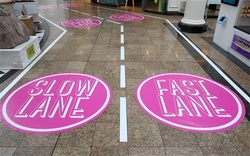
Seems like common sense, right? But retailers are just beginning to realize they can sell a lot more by slowing down shoppers, and giving them a "shopping experience."
Last October, the Wall Street Journal ran an article, The Slower You Shop, the More You Spend, in which they explored this new trend in shopping, dubbed (unsurprisingly) "slow shopping." (We can thank God for small favors - at least they didn't call it "slopping.") According to the WSJ, “slow shopping” is part of a “leisurely and enriching experience that’s not overtly focused on buying something.” It's also a great way to get shoppers to come back. People are inclined to repeat pleasant experiences.
Retail stores are employing all kinds of "experiences" designed to make shoppers hang around: Origins offers free mini-facials, Urban Outfitters hosts concerts and art events, and the Austin Whole Foods has been known hire roving mariachi bands. But one of the best ways to slow shoppers down is to get them to sit down and read.
To that end, some stores are adding libraries - comfy nooks where shoppers can sit down and leaf through a good book. New York's Club Monaco on Fifth Avenue features, among other things, a library where shoppers can read about the Flatiron district.
How to get your book into retail store libraries
If you want to get your book into retail store libraries, the first thing to do is go slow shopping yourself. Scout out which stores might be amenable to adding a comfy chair or two for shoppers to sit down and read. You may even discover that some stores in your area already have libraries.
If you think your book would be a good fit, and if the store is not national, contact the store's manager. If the store is a chain, contact the Chief Marketing Officer. Some of the CMOs named in the Wall Street Journal article are Michael Moore, the CMO for Lowes, John Nehas at Club Monaco, Oona McCullough at Urban Outfitters, and Pamela Hoffman at Origins.
If the retailer doesn't have a library, you may be able to help them start one. Make a list of some titles (yours included, of course), explain how they relate to the store's theme, and why shoppers would be interested in reading them. Mention the Wall Street Journal article, as well as other stores that are using slow shopping techniques to increase sales.
It works
Years ago, I knew a writer who wrote a humorous little book about back-seat driving. The book wasn't selling well, so he loaded a number of copies into his car, and drove to the regional headquarters of a national restaurant chain that featured an attractive gift shop. The CMO was impressed by the book (and also by the gumption of the writer), so he ordered copies for all the restaurants in the region.
Sometimes, that's all it takes. A little gumption, a good argument - and imagination. Don't let the idea that only bookstores can sell books hold you back. If you've written something outdoorsy, approach a camping store. Children's clothing outlets are great if you've written a children's book. And, of course, gaming and computer stores are perfect for speculative fiction.
At the risk of using an already over-used cliché - "think outside the box."
Retail details
In general, retailers don't order large quantities. You can expect orders from a few books to a dozen. The amount of discount you offer depends on the size of the order. (Deep discounts should not be offered unless the retailer orders books in large quantities and pays up front.) Sometimes, retailers insist on consignment, which is fine if the store is local and you can pick up the books if they don't sell. In other circumstances, especially if you have to ship the books, the retailer should pay up front. Whether you decide to offer a returns policy is up to you.
Here are some helpful articles that will give you a greater understanding of how non-traditional marketing works:
Success for Your Book – in Non-Traditional Markets
10 Ideas for Nontraditional Book Placement
How is Trade Marketing Different from Non-bookstore Marketing?
 RSS Feed
RSS Feed